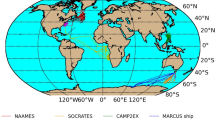Abstract
CHARLSON,et al.1 have suggested that cloud-droplet concentrations in remote marine regions might be indirectly controlled by dimethylsulphide (DMS) emissions from marine phytoplankton. Attempts to test the hypothesis that variations in DMS emissions lead to corresponding variations in marine aerosol composition and hence concentrations of cloud condensation nuclei (CCN) have so far proved inconclusive, primarily because of the inherent variability of the atmospheric species involved over the timescales typical of individual field measurements2. Here we present nine years of data from Cape Grim (41° S) which show that there is a significant seasonal relationship between cloud condensation nuclei and methanesulphonate, an easily sampled oxidation product of DMS, but the relationship is nonlinear. These results confirm that DMS emissions strongly influence CCN concentrations, but we note that at low concentrations of methanesulphonate, there are indications that there may be another source of CCN, apart from DMS.
This is a preview of subscription content, access via your institution
Access options
Subscribe to this journal
Receive 51 print issues and online access
$199.00 per year
only $3.90 per issue
Buy this article
- Purchase on Springer Link
- Instant access to full article PDF
Prices may be subject to local taxes which are calculated during checkout
Similar content being viewed by others
References
Charlson, R. J., Lovelock, J. E., Andreae, M. O. & Warren, S. G., Nature 326, 655–661 (1987).
Bates, T. S. et al. Global biogeochem. Cycles 3, 299–304 (1989).
Ayers, B. P., Ivey, J. P. & Gillett, R. W. Nature 349, 404–406 (1991).
Gras, J. L. Geophys. Res. Lett. 17, 1565–1567 (1990).
Ayers, G. P., Ivey, J. P. & Goodman, H. S. J. atmos. Chem. 4, 173–185 (1986).
Baseline Series, Ann. Rep. Baseline Atmospheric Program (Australia) (Bureau of Meteorology, Melbourne 3000, Australia, 1976–1988).
Gras, J. L. J. atmos. Chem. 11, 89–106 (1990).
Gras, J. L. & Ayers, G. P. J. geophys. Res. 88, 10661–10666 (1983).
McMurray, P. H. & Friedlander, S. K. J. Colloid Interface Sci. 64, 248–257 (1978); Atmos. Envir. 13, 1635–1651 (1979).
McMurray, P. H. J. Colloid Interface Sci. 78, 513–527 (1980).
Ayers, G. P. & Larson, T. V. J. atmos. Chem. 11, 143–167 (1990).
Burgermeister, S. & Georgii, H.-W. Atmos. Envir. A25, 587–595 (1991).
Hynes, A. J. et al. J. Phys. chem. 90, 4148–4150 (1986).
Author information
Authors and Affiliations
Rights and permissions
About this article
Cite this article
Ayers, G., Gras, J. Seasonal relationship between cloud condensation nuclei and aerosol methanesulphonate in marine air. Nature 353, 834–835 (1991). https://doi.org/10.1038/353834a0
Received:
Accepted:
Issue Date:
DOI: https://doi.org/10.1038/353834a0
This article is cited by
-
The biogeochemistry of marine dimethylsulfide
Nature Reviews Earth & Environment (2023)
-
Spectroscopic characterization of two peroxyl radicals during the O2-oxidation of the methylthio radical
Communications Chemistry (2022)
-
Production of dimethyl sulfide and acrylic acid from dissolved dimethylsulfoniopropionate during the growth of Prorocentrum minimum
Journal of Applied Phycology (2022)
-
Chemical characterization of fine aerosols in respect to water-soluble ions at the eastern Middle Adriatic coast
Environmental Science and Pollution Research (2020)
-
Biogenic production of DMSP and its degradation to DMS—their roles in the global sulfur cycle
Science China Life Sciences (2019)
Comments
By submitting a comment you agree to abide by our Terms and Community Guidelines. If you find something abusive or that does not comply with our terms or guidelines please flag it as inappropriate.



